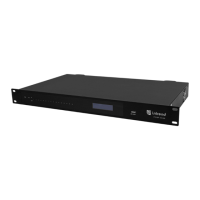Operating Manual for Digital Sound Processor (DSP) V3.0
WWW.INTREND-AV.RU
54
Device names shall also be unique on network.
Any characters can be used for naming sending channel labels, except '=', '.’and '@'.
Sending channel labels must be unique in the device.
Receiving channel naming has the same rules with sending channels.
Device Configuration:
Device configuration refers to device name modification, audio sample rate and delay. Device names
must be modified follow device name modification rules. Delay needs to be emphasized. In Dante
network, compensation is needed for various delays at receiving end. There is device setting delay
(the interface delay) at each receiving end. The delay refers to time difference between samples
received at receiving end and broadcasted. The default delay for Dante device is 1ms, which is enough
for large-scale networks.
However, automatic negotiation will be carried out at sending and receiving ends when establishing
connections, which ensures delay time is enough to prevent packet loss.
For example, Ultimo devices support minimum 1ms delay. If the delay for a faster device like PCIe
card is set at 0.25s and the device is establishing connection with an Ultimo device, then the delay of
subscription will be 1ms which is the minimum delay supported by subscriptions. If minimum delay
possibly reaches 1s in megabyte network, then subscription error may occurred when transmitting in
the condition that delay time no more than 1s.
Network Configuration:
Network configuration refers to network IP address, mask and gateway settings. Brooklyn supports
redundancy mode and exchange mode settings.
Redundancy Mode
Many Dante devices have two network ports named “Primary” and “Secondary”. “Primary”
port connects physical network. If “Secondary” port has been used, then “Secondary” port shall
connect another physical network. “Secondary” port can’t communicate with “Primary” port.

